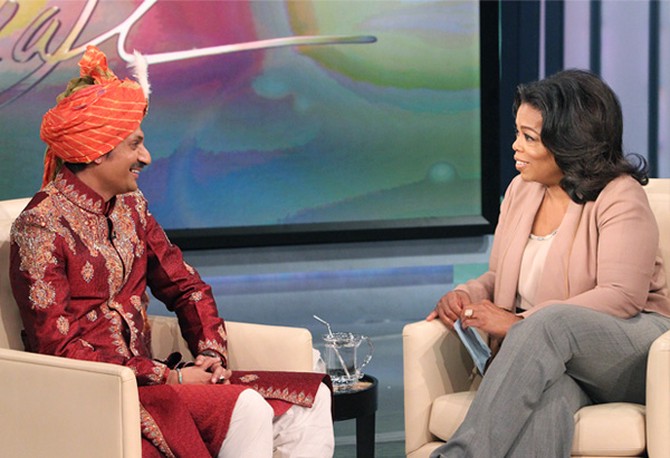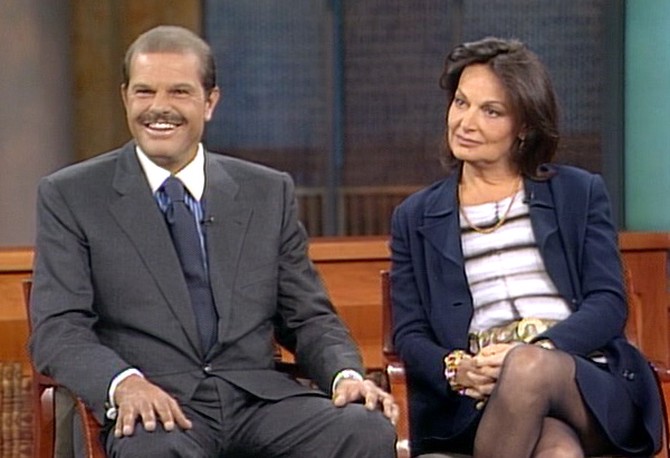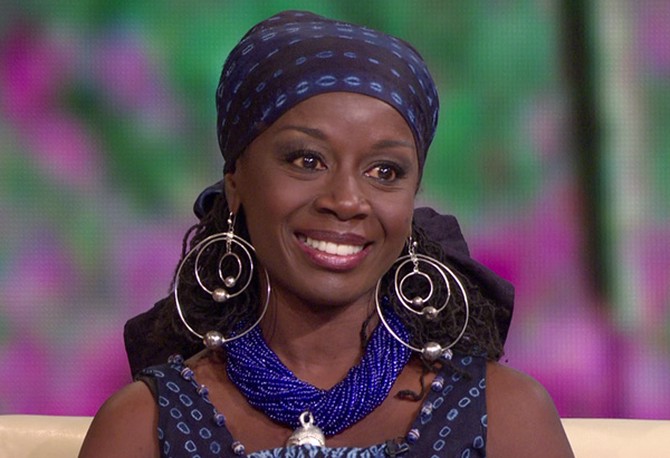Royalty on The Oprah Show
Mind your manners as you look back at when The Oprah Show has hosted royals.

Queen Rania of Jordan
In 2006, Oprah Show viewers met businesswoman, mother, glamorous international fashion icon, girls' rights crusader and world's youngest living queen—Queen Rania of Jordan. "People call me 'Queen,' but, you know, that's not me...I'm Rania."
In 2010, Queen Rania returned to The Oprah Show to talk about her adventures as a thoroughly modern monarch, complete with accounts on Facebook and Twitter, a blog, and a YouTube channel. "My virtual self can get closer to people easier than my real self," she said. "It creates a space where titles mean little and people can just say what they want."
Take a photo tour of Jordan with Queen Rania
In 2010, Queen Rania returned to The Oprah Show to talk about her adventures as a thoroughly modern monarch, complete with accounts on Facebook and Twitter, a blog, and a YouTube channel. "My virtual self can get closer to people easier than my real self," she said. "It creates a space where titles mean little and people can just say what they want."
Take a photo tour of Jordan with Queen Rania

Duchess of York, Sarah Ferguson
In May 2010, British tabloid News of the World released a video showing the Duchess of York, Sarah "Fergie" Ferguson, accepting a bribe from an undercover reporter in exchange for access to her ex-husband, Britain's Prince Andrew.
One month later, Sarah sat down with Oprah in Beverly Hills to tell her side of the story for the first time. After watching the video of herself, Sarah was apologetic. "There aren't really very many words to describe an act of such gross stupidity," she said. "It's like I'm stripped bare. I called my girls this morning, and Beatrice and Eugenie just called me and said, 'Mom, actually it's a really good, fresh clean start for you, because we're here 100 percent for you, and we love you.' And I said to them, 'I'm so glad that through my mistakes, you'll never do all this.'"
One month later, Sarah sat down with Oprah in Beverly Hills to tell her side of the story for the first time. After watching the video of herself, Sarah was apologetic. "There aren't really very many words to describe an act of such gross stupidity," she said. "It's like I'm stripped bare. I called my girls this morning, and Beatrice and Eugenie just called me and said, 'Mom, actually it's a really good, fresh clean start for you, because we're here 100 percent for you, and we love you.' And I said to them, 'I'm so glad that through my mistakes, you'll never do all this.'"

Prince Manvendra
In 2006, Oprah Show viewers met the world's only openly gay prince, Prince Manvendra Singh Gohil of Rajpipla, India. Prince Manvendra told how difficult it had been for him to come out. He was publicly rebuked by his parents and risked his freedom—homosexual acts were punishable by 10 years to life in prison.
When Prince Manvendra returned to The Oprah Show in 2011, he was happy to report that his country's attitudes about homosexuality were changing. India had overturned its anti-gay laws, gay pride parades were springing up all over the country, and Prince Manvendra was back on speaking terms with his father. "The mainstreaming has started happening," he told Oprah. "A lot of guys are actually coming out to their parents, and a few of them have even come out to the society."
When Prince Manvendra returned to The Oprah Show in 2011, he was happy to report that his country's attitudes about homosexuality were changing. India had overturned its anti-gay laws, gay pride parades were springing up all over the country, and Prince Manvendra was back on speaking terms with his father. "The mainstreaming has started happening," he told Oprah. "A lot of guys are actually coming out to their parents, and a few of them have even come out to the society."

Princess Stéphanie of Monaco
In the '80s and early '90s, Princess Stéphanie straddled the worlds of celebrity and royalty. This was only fitting since she's the youngest child born to Monaco's ruling monarch Prince Rainier III and Hollywood legend Grace Kelly. After Princess Grace was killed in a car accident in 1982, Stéphanie—who was a passenger in the car—struggled to move on.
She eventually worked as a model, was romantically linked to actor Rob Lowe and became a European pop star. When she appeared on The Oprah Show in 1991, Princess Stéphanie was promoting her album Stéphanie which had already sold 5 million copies in Europe. She explained that one song, "Born Blue," was about the sadness of growing up royal. "Why shouldn't I be allowed to be happy and even have fun?" she says. "It's a cry saying, 'When I cry, my tears are real. I hurt the same way; I laugh the same way. It's not fair to treat me any different.'"
She eventually worked as a model, was romantically linked to actor Rob Lowe and became a European pop star. When she appeared on The Oprah Show in 1991, Princess Stéphanie was promoting her album Stéphanie which had already sold 5 million copies in Europe. She explained that one song, "Born Blue," was about the sadness of growing up royal. "Why shouldn't I be allowed to be happy and even have fun?" she says. "It's a cry saying, 'When I cry, my tears are real. I hurt the same way; I laugh the same way. It's not fair to treat me any different.'"

Archduchess Michaela of Austria
Though she grew up in a castle with 36 bedrooms, Archduchess Michaela of Austria told Oprah Show viewers in 1989 that the life of a princess lacked the warmth of family. She had to make appointments any time she wanted to see her own father and grandmother. "We envied kids who could go to a normal school," Michaela—a direct descendant of Napoleon Bonaparte and Marie Antoinette—said.

"How to Marry a Royal"
In 1996, Oprah had a revealing conversation with four of the most eligible royal bachelors in the world: Prince Hubertus von Hohenlohe of Austria, Prince Louis Albert de Broglie of France, Prince Amoti Nyabongo of Uganda and Prince Charles-Henri de Lobkowicz of France. But these princes were far from what you would have expected.
Prince Hubertus was an Olympic-level skier—who represented Mexico, the country of his birth—and rockstar. "I had to hide my prince thing because of the image that you live in a castle," he said.
Prince Louis Albert was known as "the gardening prince." He had designed his own line of garden tools and turned his chateau into a bed-and-breakfast.
Prince Amoti was a Brooklyn cop.
And Prince Charles-Henri was in the process of modernizing his half-dozen French chateaus. "Royalty is mainly a sense of duty and service," Prince Charles-Henri said. "We all have our business interest, but we all maintain a sense of tradition and do what the family has always been doing, which is serving the people we take care of."
Prince Hubertus was an Olympic-level skier—who represented Mexico, the country of his birth—and rockstar. "I had to hide my prince thing because of the image that you live in a castle," he said.
Prince Louis Albert was known as "the gardening prince." He had designed his own line of garden tools and turned his chateau into a bed-and-breakfast.
Prince Amoti was a Brooklyn cop.
And Prince Charles-Henri was in the process of modernizing his half-dozen French chateaus. "Royalty is mainly a sense of duty and service," Prince Charles-Henri said. "We all have our business interest, but we all maintain a sense of tradition and do what the family has always been doing, which is serving the people we take care of."

Princess Elizabeth of Toro
Despite her elite Cambridge education and professional stints as a model and a diplomat, Uganda's Princess Elizabeth of Toro said African royals are closer to their subjects than European royalty are. "In Africa, you have to be linked to the people," she told Oprah in 1989. "I must be close and be near the people."

Prince Egon von Furstenberg of Austria
Austria's Prince Egon von Furstenberg described his life on The Oprah Show in 1996 as a fairy-tale existence. He showed off the Roman villa—one of 10 estates—that housed his wide-ranging art collection and talked about his royal upbringing. Appearing on the show with his fashion icon ex-wife Diane von Furstenberg, Prince Egon recalled why he decided to leave the castle and pursue work. "From age 18, I saw life had to be something else. I decided that starting work was something I wanted to do, not just living," he said. "I wanted to be free to do exactly what I want."

Hope Cooke, the former Queen of Sikkim
In 1989, Oprah Show viewers met Hope Cooke, a woman once known as "the intellectual's Grace Kelly." Raised in a prominent New York family, Hope met and married the crown prince of Sikkim, a small Himalayan country that bordered India, Nepal and Tibet. When Sikkim was annexed into India in 1975, the king lost his crown, the couple separated and Hope returned to America to raise their two children.

Photo: George Burns/Harpo Studios
Princess Akosua Busia of Ghana
When the cast of The Color Purple reunited on The Oprah Show in 2010, the stage was bursting with some of the biggest names in entertainment like Whoopi Goldberg, Danny Glover and Quincy Jones. But only one of actors from the legendary 1985 film was royal! Akosua Busia, who played Nettie, is a real Ghanaian princess.
Published 04/28/2011

